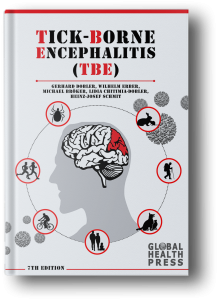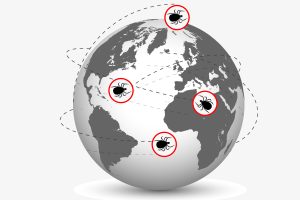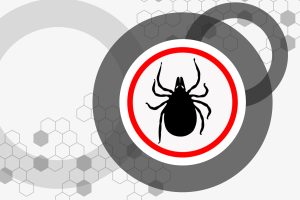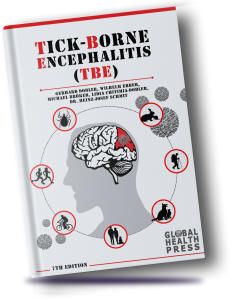
Gerhard Dobler

Wilhelm Erber

Michael Bröker

Lidia Chitimia-Dobler

Heinz-Josef Schmitt
Chapter 1: Tick-borne human diseases around the globe
- The number of tick-borne diseases is increasing due to the geographical expansion of their tick vectors, higher frequencies of infected ticks, increased awareness of infection, and improved diagnostics.
- Ticks are vectors of numerous viruses (arboviruses), bacteria, and parasites.
- Tick-borne encephalitis (TBE) and Lyme disease (LD) are the most common and most widely distributed tick-borne infections in Europe. TBE is also endemic in northern and eastern Asia, while highly endemic areas for LD include the northeastern and north-central United States.
Chapter 2: Tick -borne-flavivirus serocomplex: phylography and bio-geography

COMING SOON
Chapter 3a: Early TBE research in the Soviet Union: revisiting the narrative
- The TBE virus was first isolated in 1937 by the team of Lev Zilber during their expedition to the Soviet Far East (today the Khabarovsk and Primorie regions of Russia). The same expedition also established the connection between the disease and the tick vector.
- After the isolation of the virus, several studies established numerous older cases of TBE in the Soviet Far East, Siberia, and the Urals dating back to the early 1900s. The first retrospectively diagnosed case was identified by Mikhail Chumakov in Tatarstan and dates back to 1895.
- A separate line of Soviet research studied Kozhevnikov epilepsy (epilepsia partialis continua), one of the many possible symptoms of TBE and/or TBE sequelae. In 1922 Vladimir Omorokov examined 27 cases of Kozhevnikov epilepsy from Western Siberia and suggested that the infectious agent was linked to the forest and its insects.
Chapter 3b: Short history of TBE research and the scientists behind it
- Tick-borne encephalitis came to the attention of human medicine in the 1920s and 1930s due to economic and political changes in Far Eastern Russia and Central Europe.
- Russian scientist identified the TBEV in Far Eastern Russia in the 1930s.
- Czechoslovak scientists in the late 1940s were the first to detect TBEV in Central Europe.
Chapter 4: TBE - Virology
- TBEV is the most medically important member of the tick-borne serocomplex group within
the genus Orthoflavivirus, family Flaviviridae. - Three antigenic subtypes of TBEV correspond to the 3 recognized genotypes: European
(TBEV-EU), also known as Western, Far Eastern (TBEV-FE), and Siberian (TBEV-SIB).
An additional 2 genotypes have been identified in the Irkutsk region of Russia, currently named
TBE virus Baikalian subtype (TBEV-BKL) and TBE virus Himalayan subtype (Himalayan and “178-79” group; TBEV-HIM). - TBEV virions are small enveloped spherical particles about 50 nm in diameter.
Chapter 5: TBEV transmission and natural cycles
- The natural cycle of the TBE virus is dependent on vector ticks and reservoir hosts.
- There are differing transmission cycles in varying environments, from cold northern coniferous forests to temperate central European forests.
- Within a natural transmission cycle, there are different ways of transmission – tick-to-tick (transovarial, sexual), host-to-tick (viremic), and tick-to-tick and host-to-host.
Chapter 6: Pathogenesis of TBEV diseases
- In this chapter, we describe the pathogenesis of tick-borne encephalitis virus (TBEV).
- To cause infection, TBEV needs to cross three different barriers; the physical, the innate and adaptive, and the blood-brain barrier.
- TBEV transmission at the skin interface is pro-inflammatory with a marked increase in immune cell infiltrates at the tick-feeding foci.
Chapter 7: Immunology of TBEV infection
- The host immune response to Tickborne Encephalitis Virus (TBEV) infection involves the coordination of multiple immune subsets at several distinct tissue sites over time.
- Contributions from both early innate and later adaptive immune responses are critical in controlling TBEV infection.
- Early innate immune responses are driven by Type I interferon-mediated signaling and are dominated by neutrophils and natural killer cells.
Chapter 8: TBE in children
- TBE follows a similar clinical course in children and adults, manifesting mainly as meningitis. However, a broader clinical picture is seen in children, especially in preschool age.
- Laboratory evaluation may show elevated blood inflammatory indices, but cerebrospinal fluid analysis and anti-TBEV serology are still crucial for establishing the TBE diagnosis.
- The case fatality in pediatric TBE is overall very low. However, severe cases also occur in the pediatric population.
Chapter 9: TBE in adults
- Tick-borne encephalitis (TBE) is a viral infectious disease in humans that involves the nervous system.
- Frequently, there is a febrile illness phase 1-21 days before the onset of neurological and neuropsychiatric symptoms.
- The most common neurological manifestations include meningitis, encephalitis, myelitis, radiculitis, or a combination thereof.
Chapter 10: TBE in animals
- TBEV-infection can cause symptomatic disease in dogs and horses, similar to the TBE in humans.
- Microbiological confirmation of TBEV infection in animals is similar to diagnostics in humans.
- Domestic ruminants may serve source of human infection via the alimentary routs (dairy products).
Chapter 11: Diagnostic of TBEV infections
- TBE appears with non-characteristic clinical symptoms, which cannot be distinguished from other forms of viral meningitis encephalitis, or other diseases.
- Cerebrospinal fluid and neuro-imaging may give some evidence of TBE, but ultimately cannot confirm the diagnosis.
- Thus, proving the diagnosis “TBE” necessarily requires confirmation of TBEV infection by detection of the virus or by demonstration of specific antibodies from serum and/or cerebrospinal fluid.
Chapter 12: Epidemiology of TBE
- TBE is a flavivirus infection of the central nervous system (CNS), transmitted by ticks and in some rare instances by ingestion of unpasteurized milk
- It is diagnosed in the Boreal and Temperate Forest Belt of Eurasia ranging from the UK, eastern France, The Netherlands, and Norway down to Italy through central and Eastern Europe, Russia, Kazakhstan, and China to Japan.
- About 10,000 cases of TBE are reported annually, likely a significant underestimate as serological testing is more sporadic than complete and, in some countries, (like Japan) not even available.
Chapter 13: Countries with confirmed TBE
- While TBE is listed as a “communicable disease” in the EU since 2012, each country implements reporting nationally with own resources and methods.
- In most instances, reporting of TBE cases is based on passive surveillance, and thus largely depend on disease awareness with physicians and on availability, cost and use of serological tests for TBE diagnosis.
- Systematic, regular use of TBE serology in the appropriate clinical setting is in place in few countries only, despite the fact that it would be a necessary prerequisite to gain reliable data on the true incidence of TBE in a given country.
Chapter 14: Public health aspects of TBE
- The identification of TBE endemic areas is crucial to inform national and international TBE risk management programs. However, identification of TBE endemic areas remains incomplete.
- The risk of tick-borne disease is predicted to increase with climate change through several mechanisms, but the relationship between climate and tick-borne disease is complex and influenced by both environmental and human factors.
- Uptake and compliance with TBE vaccination in Europe vary greatly, with overall low rates.
Chapter 15: TBE vaccines licensed around the globe
- Worldwide there are 6 different TBE vaccines – two from Western Europe, three from Russia, and one from China. The two Western European vaccines and one of the Russian vaccines have an adult and a pediatric formulation.
- The product names are FSME IMMUN and FSME-IMMUN Junior; Encepur adults and Encepur children, Klesch-E-Vac, EnceVir, and EnceVir Neo, Dry lyophilized TBE Moscow and Sen Tai Bao.
- All TBE vaccines except the one from China have similar but not identical immunization schedules with primary immunization (3 to 4 doses according to vaccine) and regular booster vaccinations. For FSME-IMMUN, Encepur and EnceVir rapid immunization schedules are also licensed. The Chinese vaccine is given with 2 primary doses 2 weeks apart followed by annual boosters.
ONLINE VERSION
Click on the image above
to view the online flip version
doi:10.33442/26613980_TBE-7
TBE NEWSLETTER 2024
WEEKLY SNAPSHOTS 2024
TBE NEWS ARCHIVES
TBE SNAPSHOTS ARCHIVES
3RD EDITION
Click on the image above to view the online flip version
Download the TBE Book in PDF format
The publication of “The TBE Book” was funded by Pfizer Inc.
4TH EDITION
Click on the image above to view the online flip version
Download the TBE Book in PDF format
The publication of “The TBE Book” was funded by Pfizer Inc.
5TH EDITION
Click on the image above to view the online flip version
Download the TBE Book in PDF format
The publication of “The TBE Book” was funded by Pfizer Inc.
6TH EDITION
Click on the image above to view the online flip version
Download the TBE Book in PDF format
The publication of “The TBE Book” was funded by Pfizer Inc.
7TH EDITION

Click on the image above to view the online flip version
Download the TBE Book in PDF format
The publication of “The TBE Book” was funded by Pfizer Inc.
Everyone has permission to download the TBE book for free
See list of contribution Authors























